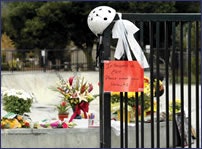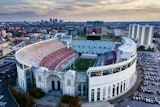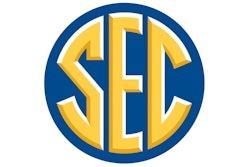Skateboarding claims Eric Costello, a popular professional, reigniting the debate over helmet laws in skate parks.
 Photo by Shmuel Thaler/Santa Cruz Sentinel
Photo by Shmuel Thaler/Santa Cruz Sentinel
But Costello's helmet flew off when he lost his balance during his patented "Costello Gap" - a big frontside maneuver in which he would roll into the bowl from atop an 8 1/2- to 9-foot ledge, launch off a smaller 2- to 3-foot lip, shoot a gap and land on the downslope of another 3-foot section. Costello, having built up enough momentum, tripped before shooting the gap and awkwardly fell headfirst, his skull smashing onto the concrete bowl several feet below.
Having suffered severe head trauma, the unconscious Costello was airlifted from the scene to a local hospital, where he died two days later.
In the weeks following, some members of the California skateboarding community - including the creator of a web site called Realskate.com - called Costello's death a freak accident, and cautioned against reactionary helmet laws. But others weren't willing to blame Costello's death on mere coincidence. Some supporters of a "Helmets for Life" rally - held at Scotts Valley's Tim Brauch Memorial Skatepark nearly two weeks after Costello's fatal fall - claimed that stricter helmet enforcement at skate parks is precisely what's needed to prevent another tragedy.
"Skateboarders just have to figure out it's cool to wear a helmet. They're doing what they love and if they don't wear a helmet, that could come to an end," Rich Harris, owner of Dislocated Skate Shop in Scotts Valley, told the Santa Cruz (Calif.) Sentinel in November. "If it can happen to Costello, it can happen to anybody."
"Accidents happen" is a truism that applies as much to skateboarding as any sport. But in skateboarding, despite the supposedly fearless nature of many of the sport's participants, fatalities are exceedingly rare.
According to the U.S. Consumer Product Safety Commission, most reported skateboarding injuries involve sprains, fractures and abrasions. Head injuries represent a small percentage of the total number, and deaths resulting from head injuries are almost nonexistent.
In fact, in her 10 years of involvement in the skateboarding industry, Heidi Lemmon has known of only four deaths taking place in skate parks. To her knowledge, Costello's was the first such tragedy to take place in a California skate park.
Lemmon, director of the grassroots Skate Park Association of the United States of America (SPAUSA), doesn't believe that a flaw in the design of the Tim Brauch Skatepark contributed to Costello's accident.
But she also hesitates to place the blame on the skateboarder himself. "At the time he died, this fellow was riding a big bowl, which is an appropriate place to have on helmets and pads," says Lemmon, contrasting "vert" skating (dropping from extreme heights) with street style (riding on or around ordinary streetscape obstacles). "He was doing everything right - he was in a skate park, he was wearing a helmet."
Yet it's hard to ignore police reports indicating that at some point Costello's helmet popped off, leaving his skull vulnerable. Though he'd rather not speculate for lack of firsthand evidence, Randy Swartz, director of the Bicycle Helmet Safety Institute in Arlington, Va., thinks he can explain Costello's equipment malfunction. "The ironic thing about his death is that skateboard helmets normally fit really well because they have additional coverage in the back," he says. "And as a result, if you have the strap buckled, they almost always stay on. That's why I suspect that maybe his wasn't buckled. He may have had it off and on while he was leading his workshop, and just put it on but didn't buckle it."
If, in fact, a properly worn helmet may have prevented Costello's death, why all the debate now over helmet laws for skateboarders?
Lemmon suspects that Costello's accident was exactly the type of bad news for which opponents of public skate parks were "lying in wait." "It's the ammunition that they're looking for because they're so prejudiced against these kids to begin with," she says. "There are at least a couple of kids killed in baseball each year. And I know kids die in football, either from injuries or overtraining and heat exhaustion. You have deaths in all kinds of sports. And no one ever tries to shut down Little League or football. But if you get one death in skateboarding, suddenly they threaten to close down every park, and have all these sanctions on the kids."
As little as five years ago, the disconnect between skateboarders and leaders of many municipal governments was vividly apparent. If those same leaders suddenly crack down on skateboarders who don't adhere to helmet laws - which, incidentally, apply in only 13 states, including California - Lemmon predicts that the effect would be counterproductive. "For everybody to all of a sudden jump to make sanctions to ensure that no skateboarder is ever injured again, they can cross the fine line to where people who don't skateboard control the activity."
What could be worse for a sport - despite boasting mainstream commercial appeal today - borne of a late 1950s counterculture movement?
With that in mind, Swartz suggests a happy medium. He points to one brand of retro-style helmets that enable skateboarders to maintain their jagged-edge persona while riding safely. Popularized by one of the original skate helmet companies in the 1970s, the classic skate-style helmet features a round, smooth hard shell and small round vents. Today, the helmets carry dual certification, meeting both ASTM International's F1492 multi-impact skateboarding guideline and the CPSC bicycle helmet standard - thanks to a resilient, expanded polypropylene foam tucked inside.
The classic helmet is popular with teenagers and older professional skaters alike, not only because it's cool - "It doesn't look anything like Lance Armstrong's helmet," says Swartz - but also because skateboarders are just as concerned with their own safety as are municipal government officials. "It's not as difficult as you might think" to get skateboarders to wear helmets, Swartz says. "Some of them do have a sense of self-preservation. They wear pads, so they're trying to keep their skin on. They might as well try to keep their brains from falling out, too."
Lemmon passionately reminds non-skateboarders - recreation administrators, city council members and parents, in particular - to appreciate that what they don't entirely understand isn't necessarily cause for concern. "My experience with skateboarders is that they pretty much know their own sport," she says. "They know the risks and the equipment that's required."
To Lemmon, Costello was not so different from any football player who chooses to take the field, despite the sport's life-threatening risks. "People aren't going to stop doing what they love doing," she says, adding that Costello's chosen style, vert, is practiced only by a small percentage of skateboarders, in part because it is extremely challenging - and dangerous. "Honestly, this is really tragic, but it's something that I had to face 10 years ago when we started lobbying for skate parks. We knew, of course, there were going to be broken arms and legs. But we also knew that eventually, someone would die. You're going to get some deaths at skate parks. There's just no way around it."




































